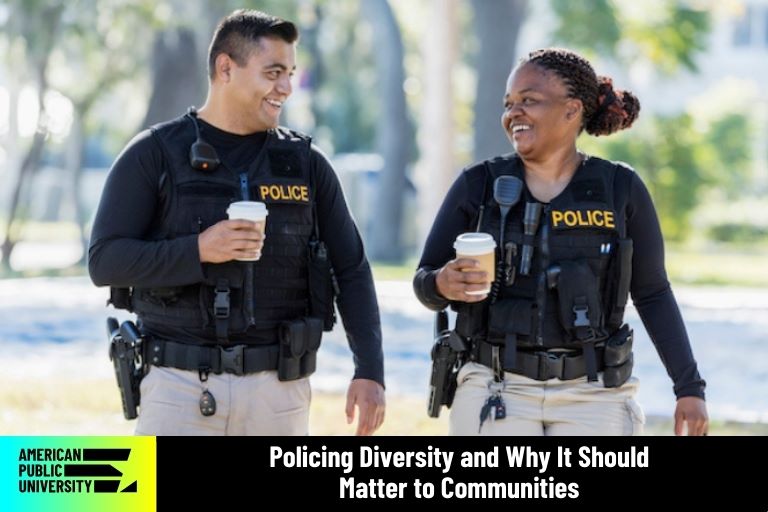By Dr. LaLanya Fair | 11/14/2023

To understand the importance of diversity when it comes to policing, there must first be clarity on what police diversity actually means. Police diversity is commonly defined as the presence of a variety of officers from different backgrounds, including age, cultural, racial, economic, and educational backgrounds, in a unit or department.
Diversity in law enforcement also includes a variety of skills and duties, life experiences, and perspectives. The goal of a diverse police force is to have a group of cops who can represent and relate to all the people within the community area that they patrol.
The Benefits of Police Diversity
There can be numerous benefits to diversity within law enforcement organizations. For example, representation of other minority groups in law enforcement agencies helps to increase the legitimacy of law enforcement in the eyes of the public, especially among Black civilians.
Black officers are seen as more knowledgeable about diverse communities and minority cultures, according to researchers Scott Decker and Russell Smith. Also, they may be more empathetic to minority concerns, notes researcher Herman Goldstein.
Using law enforcement officers from different ethnic backgrounds can also lead to an increase in the contact between white officers and minority officers. This diversity potentially helps to increase familiarity and reduce hostility between officers, potentially changing a law enforcement agency's culture toward a more positive view of minority communities. In addition, the employment of minority police officers could potentially reduce the solidarity of the police subculture, according to scholars Samuel Walker, Cassia Spohn, and Miriam DeLone.
The International Association of Chiefs of Police notes that police diversity has a direct effect on the amount of trust and goodwill a police department enjoys and an increase in public safety. The presence of Black and Hispanic officers, as well as female officers, also encourages community members of the same racial background to identify with law enforcement officers, leading to a more positive relationship with law enforcement and an increase in compliance with legal demands. Ideally, police officers should strive to be as multifaceted as the communities that they work in.
Being inclusive in law enforcement helps contribute to improving police officers' effectiveness in criminal justice. Often, police officers who have greater cultural diversification and language skills are better able to engage in unique cultural contexts of their service area.
Additionally, a police department with greater law enforcement diversity has a greater chance of identifying non-conformists. Allowing officers to use their ethnic backgrounds and unique cultural knowledge can also help them develop innovative and creative solutions to reduce crime in the communities they serve and improve public safety.
Also, a more diverse workforce can lead to an improved criminal justice decision-making process. A diverse police department affords officers the opportunity to draw from different backgrounds, opinions, and experiences to inform decision-making. As a result, policy-making decisions can be made with the input of individuals who are familiar with the perspectives of those members of the public most impacted by criminal justice regulations.
Having diverse law enforcement officers also offers numerous benefits to society. The presence of diverse officers in a police department can increase community trust and the rate of citizen cooperation. In cities where community relations are strained or have collapsed due to past practices, gaining public trust and citizen cooperation is particularly important.
Using diverse law enforcement officers encourages police departments to focus on cultural sensitivity training and community policing. In addition, having racially diverse officers can mitigate racial bias used in the exercise of policing powers and create a force that better reflects the population they serve.
Diversity can also help improve law enforcement performance. Through diversification, an agency can attract new recruits who possess a variety of talents and skills and have the in-depth cultural knowledge that can help to solve complex problems.
Finally, having a diverse law enforcement agency also helps make agencies more attractive places in which to work. Many police departments are facing recruitment and retention challenges, due to a shrinking pool of qualified applicants and an inability to retain candidates beyond their probationary period.
Related: Recruiting and Hiring the Next Generation of Police Officers
Changing the Perception of What a Police Officer Should Look Like
in 2021, researchers found that female officers and nonwhite officers make far fewer stops, use less force, and have far fewer negative interactions during traffic stops than their white male counterparts. Consequently, it would be prudent to look at how building more diverse law enforcement organizations would encourage police officers to make fewer stops, use less force, and have more positive interactions with a wider range of community members.
Traditionally, U.S. police forces have been comprised of mainly male white officers. Over a half-century ago, the largest law enforcement departments in the nation had at least 10 white officers for every nonwhite officer, according to the U.S. Department of Justice.
In 1993, not less than three-fourths of full-time sworn personnel of local U.S. police departments were male and white, observes researchers Brian Reaves and Andrew Goldberg. In 2016, almost two-thirds of the nation of full-time sworn police officers were male and white, notes Bureau of Justice statisticians Shelley Hyland and Elizabeth Davis.
The issue of workforce diversification achieved greater prominence with the May 2020 death of George Floyd. Floyd was an unarmed Black man killed by a white police officer using excessive force, and his death resulted in public demonstrations against police brutality and systemic racism.
Floyd’s death and similar previous incidents served as a catalyst for national discourse on reforming law enforcement. Calls for change vary significantly by focus, complexity, and depth. Regardless of the form such initiatives take, they will – given the bureaucratic complexity of law enforcement organizations – take time to come to fruition.
Related: Criminal Justice Degrees and Using Real-World Experience
Focusing on Diversity in Law Enforcement
Many law enforcement organizations have staff recruitment policies that encourage more diversity training and make sure that diverse candidates like African Americans, women, and other groups are part of the recruitment process. However, it still has not been easy for these organizations to address the lack of inclusiveness.
One of the primary reasons is the overwhelming rate of staff turnover in the law enforcement field. Due to the long and often overwhelming nature of police work, which often includes working long hours and public scrutiny, many potential candidates are simply unwilling to commit to a law enforcement job.
Additionally, many law enforcement organizations face intense competition for job candidates, because the private sector often offers benefits and wages that the public sector simply can’t match. This competition further weakens the pool of available applicants and also cuts into the potential pool of diverse job seekers.
Finally, many law enforcement organizations face a great deal of public resistance when it comes to diversifying their ranks. Many residents of the community that law enforcement agencies work in can develop a feeling of distrust toward police officers of different ethnic backgrounds, which can make recruitment more difficult.
Promising Practices for Increasing Diversity in Law Enforcement
Finding quality candidates who have diverse characteristics is not hard to do. However, finding quality candidates who have different perspectives and life experiences can be a challenge.
Chicago has made strides in this area by establishing a Recruitment Unit in 2021. It was created to help the Chicago Police Department find the best civilians to fill the role of police officer.
Members of the Recruitment Unit host informational events open to the public, attend local job fairs, and even travel across the county to Historically Black Colleges and Universities (HBCUs) and military bases. This unit has made a commitment to build a more culturally diverse law enforcement department that mirrors Chicago’s community.
Last year, the CPD waived the requirement to have 60 credit hours toward a degree as long as a candidate was able to meet one of eight other criteria to become an entry-level police officer. The other criteria to become an officer includes 30 credit hours toward a degree, work and life experience, military experience, or a combination.
CPD also formed a partnership with Olive-Harvey College, so that qualified candidates to complete their criminal justice degree in one year. Students can then earn 60 credits, which fulfills CPD’s educational requirement.
These innovative ideas allowed the Chicago Police Department to host numerous online and in-person exams, which resulted in them hiring 956 new police officers. One-third of this group was women, and almost 70% of the new police officers were people of color.
In order for a police agency to properly move towards more inclusivity in our nation, they must focus on recruiting, developing an equitable hiring process, and providing support systems for their existing employees. As research in this area continues, the focus of law enforcement departments should be to consider the best practices for creating a diverse, equitable law enforcement agency with the potential to understand and serve their communities more efficiently.
Much of the existing research on police diversity has put a strong emphasis on the relationship between police and the community. However, there is a need for future research to look at how police diversity can result in real performance gains.
This research, for example, should also address the wide range of institutional challenges that can prevent police departments from achieving higher levels of diversity, including recruitment and retention challenges. Finally, research should look to identify successful models of diversity work that have occurred within local law enforcement organizations.
Police agencies should take the initiative to provide resources and support systems for their existing diverse personnel to increase their retention rate. They should ensure that every officer receives adequate and continuous diversity training throughout his or her career.
That effort will create a system through which officers can address any concerns or complaints and can also produce a positive work culture in which all officers can express their opinions and ideas. If these efforts are continuous and built upon in the future, they could lead to improved public trust of law enforcement officers, increased community collaboration, and improved criminal justice outcomes.
Dr. LaLanya Fair is a part-time instructor for the School of Security and Global Studies. She holds a bachelor’s degree in business and information systems from the University of Phoenix, a M.S. in criminal justice and homeland security administration from Tiffin University and a Ph.D. in business administration with a concentration in homeland security and leadership policy from North

